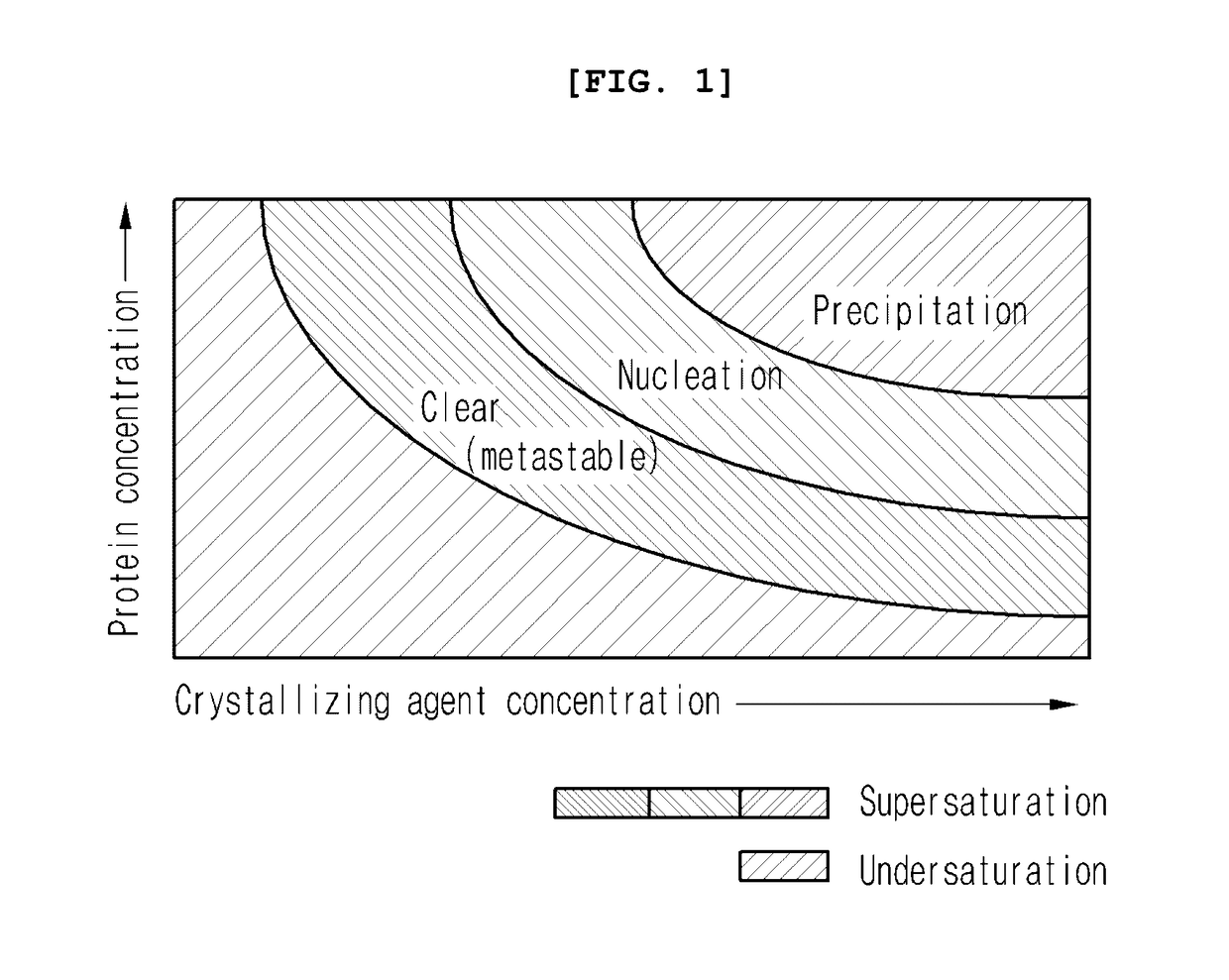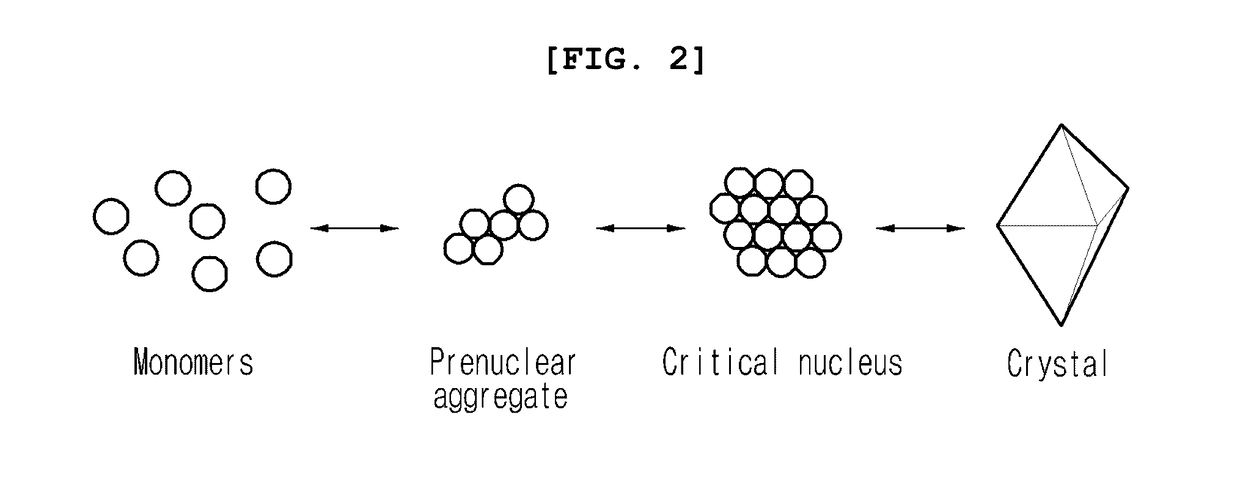Method for using nanoparticles as nucleation agents for the crystallization of proteins
a technology of nanoparticles and nucleation agents, which is applied in the direction of polycrystalline material growth, crystal growth process, peptides, etc., can solve the problems of only applying methods to those proteins, non-selective methods, and still depends on the success rate of protein crystallization, so as to increase the chance of successful crystallization and improve the success rate of crystallization. , the effect of prediction
- Summary
- Abstract
- Description
- Claims
- Application Information
AI Technical Summary
Benefits of technology
Problems solved by technology
Method used
Image
Examples
example 1
of Gold Nanoparticles
[0056]In the course of the crystallization of such proteins having his-tag on their amino terminals as Bacillus subtilis YesR, chicken egg white lysozyme, bovine serum albumin, Alicyclobacillus acidocaldarius acetyl-CoA carboxylase, and Listeria monocytogenes hypothetical protein, the effect of gold nanoparticles was examined. To do so, 14 different gold nanoparticles were synthesized as follows: gold nanoparticles in the shape of sphere having different diameters of 5, 10, 15, 18, 20, 50, and 100 nm, nanoparticles in the shape of rod having different sizes of 15×36 and 15×55.5 nm, and nanoparticles in the shape of star having different diameters of 15, 30, 60, 125, and 230 nm.
Synthesis of Gold Nanoparticles in the Shape of Sphere
[0057]To synthesize gold nanoparticles in the shape of sphere, hydrothermal synthesis was used, wherein chloroauric acid (HAuCl4), the precursor, was heated in the presence of sodium citrate as a surface stabilizer. The size of the nan...
experimental example 2
tein Using Gold Nanoparticles
[0071]Crystallization of four proteins having his-tag at amino terminal (chicken egg white lysozyme, bovine serum albumin, Alicyclobacillus acidocaldarius acetyl-CoA carboxylase, and Listeria monocytogenes hypothetical protein) was performed using the gold nanoparticles synthesized in Examples and .
[0072]Particularly, the proteins used herein were chicken egg white lysozyme (7.8 mg / ml), Bovine serum albumin (13.4 mg / ml), Alicyclobacillus acidocaldarius acetyl-CoA carboxylase (13.6 mg / ml), and Listeria monocytogenes hypothetical protein (12.1 mg / ml). These proteins were dissolved in the buffer composed of 20 mM Tris-HCL (pH 7.5), 200 mM NaCl, and 1 mM NiCl2. A 96-well sitting drop plate was used for the crystallization of protein (FIG. 8). As shown in FIG. 9 and FIG. 10, 70 ml of MCSG 2T (96 conditions), the crystallization solution provided by Microlytic, was loaded in each well. 0.5 ml of the crystallization solution was mixed with 0.5 ml of the protei...
experimental example 3
tein Using Gold Nanoparticles in the Shape of Star
[0075]Crystallization of chicken egg white lysozyme having his-tag at amino terminal was additionally induced with the gold nanoparticles in the shape of star synthesized in Example .
[0076]Particularly, the protein, chicken egg white lysozyme (7.8 mg / ml), was dissolved in the buffer composed of 20 mM Tris-HCl (pH 7.5), 200 mM NaCl, and 1 mM NiCl2. A 96-well sitting drop plate was used for the crystallization of protein (FIG. 8). As shown in FIG. 9 and FIG. 10, 70 ml of MCSG 2T (96 conditions), the crystallization solution provided by Microlytic, was loaded in each well. 0.5 ml of the crystallization solution was mixed with 0.5 ml of the protein solution containing gold nanoparticles (2×107 particles / ml), resulting in the preparation of 1.0 ml drop. 10,000 gold nanoparticles were included in a drop, and the plate was sealed with transparent tape (FIG. 9 and FIG. 10). The prepared plate was stored at 20° C. and the crystallization was ...
PUM
| Property | Measurement | Unit |
|---|---|---|
| diameter | aaaaa | aaaaa |
| length | aaaaa | aaaaa |
| length | aaaaa | aaaaa |
Abstract
Description
Claims
Application Information
 Login to View More
Login to View More - R&D
- Intellectual Property
- Life Sciences
- Materials
- Tech Scout
- Unparalleled Data Quality
- Higher Quality Content
- 60% Fewer Hallucinations
Browse by: Latest US Patents, China's latest patents, Technical Efficacy Thesaurus, Application Domain, Technology Topic, Popular Technical Reports.
© 2025 PatSnap. All rights reserved.Legal|Privacy policy|Modern Slavery Act Transparency Statement|Sitemap|About US| Contact US: help@patsnap.com



